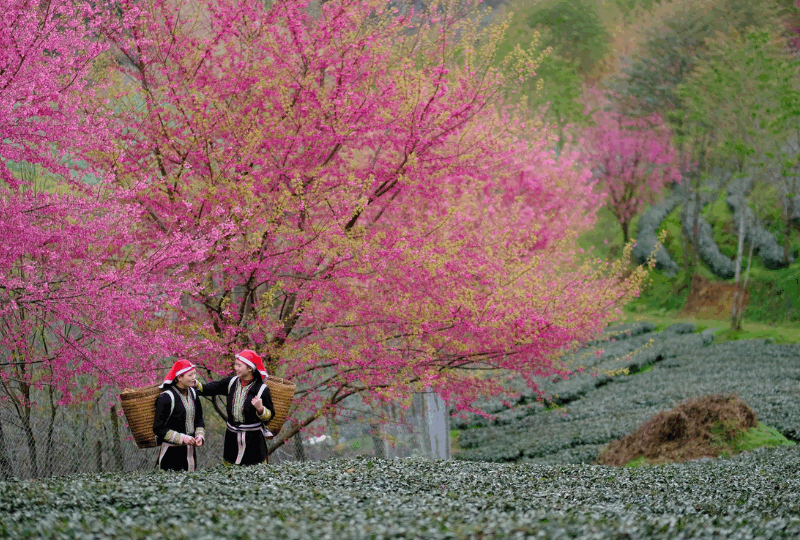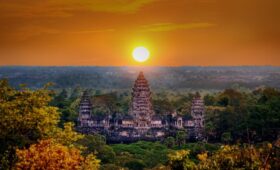1. Overview
Northern Vietnam is a place where long history, majestic nature and unique traditional culture intersect, giving visitors a journey that is both profound and full of surprises. The Northern Vietnam itinerary below will take you through the most prominent destinations, from the ancient capital to the mountains and forests of the Northwest and the natural wonders of the islands.
2. The best time to visit Northern Vietnam
The North has four distinct seasons, with autumn (September – November) and spring (March – April) considered the most ideal for travel due to their cool weather, little rain and stunning scenery. Winter from December to February can be cold, especially in mountainous areas like Sapa, while summer is often rainy and hot.
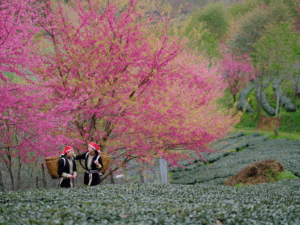
Going to Sapa in December, you have the opportunity to see the most beautiful cherry blossom season of the year. (Source: internet)
3. How to get to Vietnam and get around in the North
The Northern Vietnam itinerary often begins in Hanoi, where Noi Bai International Airport is directly connected to many major cities such as Bangkok, Seoul, Tokyo or Paris. From the airport, you can easily travel to the center by taxi, technology car or shuttle bus in just 30 – 45 minutes.
From Hanoi, you can reach Sapa, Ha Giang, Ninh Binh or Ha Long by long-distance limousine, train or high-quality passenger car with flexible schedules throughout the day. For long routes or mountain passes, you should choose a private car with a driver to ensure safety and be more proactive when stopping to visit.
At the destination, visitors can rent a motorbike, use an electric car, cycle or walk to explore the alleys, villages and local attractions. Some areas such as Ninh Binh, Sa Pa or Hanoi’s Old Quarter also provide bicycle or cyclo services to experience the slow and intimate atmosphere.
4. Accommodation in Northern Vietnam
In Hanoi, visitors can choose 4-5 star hotels such as Lotte Hotel, Capella Hanoi or boutique hotels located in the Old Quarter with French architecture. In Sapa, you can stay at mountain-view resorts such as Topas Ecolodge or Hotel de la Coupole – where luxurious architecture and breathtaking natural views combine. In Ha Long and Ninh Binh, luxury cruises such as Paradise Elegance, Ambassador Cruise or eco-bungalows in the mountains and forests are ideal choices for a relaxing and close-to-nature vacation.
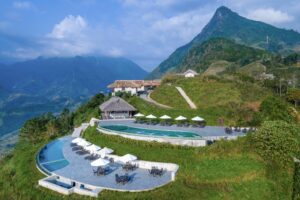
Beautiful Resort Topas Ecolodge Sapa. (Source: internet)
5. Suggested 7-day Northern Vietnam Itinerary
5.1. Day 1 – Ancient and vibrant Hanoi
Hanoi is the capital of a thousand years of culture, famous for its ancient French architecture, historical and cultural relics imbued with traditional Vietnamese identity. Taking a city tour, you will have the opportunity to visit the Temple of Literature – Quoc Tu Giam, Hoan Kiem Lake – the sacred symbol in the heart of the Old Quarter with landmarks in the lake area such as The Huc Bridge, Ngoc Son Temple, Turtle Tower can let you check in, take beautiful souvenir photos.
The Old Quarter with 36 streets will be where you can clearly feel the rhythm of Hanoi life, where each street is associated with a traditional profession and has its own soul. You can spend time walking around Dong Xuan market, enjoying egg coffee on Nguyen Huu Huan street or enjoying bun cha at the restaurant that once welcomed President Obama.
If you love art, you can choose to watch traditional water puppetry at Thang Long Theater. This will definitely be an interesting experience for the first day of your Northern Vietnam itinerary.
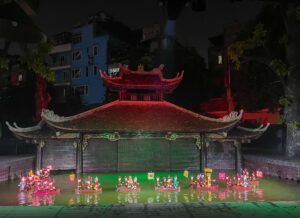
Water puppetry is a unique traditional art form of Vietnam. (Source: Ministry of Culture, Sports and Tourism)
5.2. Day 2 – Mysterious Sapa in the Clouds
Sapa is a famous highland town of Lao Cai, surrounded by the majestic Hoang Lien Son range and green terraced fields, an ideal place for tourists who love nature and ethnic culture. You will experience the feeling of floating in the early morning mist and explore Cat Cat village with the rustic lifestyle of the H’Mong people.
Try to challenge yourself by conquering Fansipan peak by cable car – the roof of Indochina with an altitude of 3,143m, or trekking to Lao Chai – Ta Van, admiring Muong Hoa valley and majestic terraced fields. If you are an adventure lover, this is definitely an activity not to be missed in your Northern Vietnam itinerary.
The evening in Sapa has a pleasant cool air, you can sit by the charcoal stove to enjoy grilled stream fish, suckling pig and apple wine, and participate in the night markets to feel the rhythm of life of the highland people.
5.3. Day 3 – Explore Bac Ha and the highland market
From Sapa, you can continue your journey to Bac Ha – the capital of the White H’Mong people, famous for its colorful market every Sunday morning. Bac Ha market is not only a place to trade goods but also a cultural meeting place, where highland people meet, exchange, interact and express their national identity.
Don’t miss the opportunity to enjoy the typical thang co dish and traditional corn wine, amidst the space filled with the sound of Mong pipes, horse hooves and colorful ethnic costumes. This is one of the most unique markets that still preserves the ancient lifestyle, a must-see destination on every Northern Vietnam itinerary.
In addition to the market, you can visit Hoang A Tuong mansion – a rare architectural relic in the mountains and forests, combining unique French and Chinese styles, or explore villages such as Ban Pho – the most famous corn wine producer in the region.
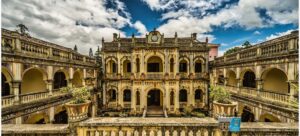
Hoang A Tuong Palace – An ancient mansion in the Bac Ha highlands with a unique Asian – European style. (Source: internet)
5.4. Day 4 – Majestic Ha Long Bay in the Northeastern Sea
Ha Long Bay is a natural wonder of the world, recognized by UNESCO with more than 1,900 large and small limestone islands rising from the blue water. Visitors will have the opportunity to board a cruise to spend the night in the middle of the bay, enjoy fresh seafood and watch the sunset covering the strangely shaped rocky mountains.
The excursion will take you through Thien Cung Cave, Sung Sot Cave, Titop Island, Cua Van fishing village – a place that preserves the traditional sea lifestyle for many generations. You can kayak, swim or simply lie on the deck and enjoy the absolutely peaceful atmosphere.
At night in Ha Long Bay, you can go squid fishing, take a cooking class on the boat or watch the starry sky, in the sound of gentle waves and the gentle salty breeze of the sea.
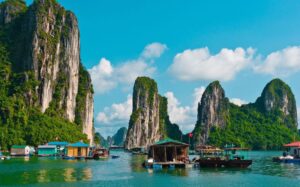
Ha Long has countless large and small islands rising above the blue water. (Source: internet)
5.5. Day 5 – Ninh Binh: Trang An and Hoa Lu Ancient Capital
Ninh Binh is a land that combines natural heritage and historical relics, notable for its spectacular karst cave system and vestiges of the ancient capital. This is definitely a destination that tourists cannot miss on their Northern Vietnam itinerary.
You will experience a dugout canoe journey through Dia Linh Cave, Nau Ruou Cave, and lush green valleys at Trang An – a dual heritage complex recognized by UNESCO. Visitors can also visit Bai Dinh Pagoda – the largest pagoda complex in Southeast Asia with massive Buddha statues, long La Han corridors and a peaceful space among the hills.
Hoa Lu Ancient Capital – the first capital of Dai Co Viet – will be where you will learn about the history of the Dinh – Le dynasties, through the kings’ temples and architectural relics remaining in the heart of the quiet limestone valley.
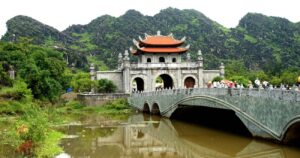
The Hoa Lu Ancient Capital Special National Monument Complex is a destination that attracts millions of domestic and international tourists every year.(Source: internet)
5.6. Day 6 – Tam Coc – Bich Dong and Ninh Binh Craft Villages
Tam Coc is known as “Ha Long Bay on land” with a system of limestone mountains interspersed with the winding Ngo Dong River, offering a wonderful relaxing journey by bamboo boat. You will admire the golden rice fields in the summer and feel the pristine tranquility of the Northern Delta.
Bich Dong is an ancient pagoda built in the heart of the mountain, with three floors connected by stone caves and ancient stairs, opening up a beautiful panoramic view of Tam Coc. This is a destination that harmoniously combines beliefs, architecture and landscape.
In addition, you can visit Van Lam embroidery village or Gia Thuy pottery village, where visitors can directly experience traditional handicrafts and bring back souvenirs with a strong local imprint.
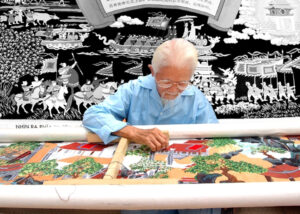
Famous lace embroiderer in Van Lam Embroidery Village – Keeping Vietnamese soul in every needle and thread. (Source: internet)
5.7. Day 7 – Return to Hanoi, explore the remaining places you haven’t had time to visit
On the last day of the Northern Vietnam itinerary, a popular activity that attracts tourists that you should try is attending the flag-raising ceremony at Ba Dinh Square. After that, visitors can visit the Ho Chi Minh Mausoleum and the Presidential Palace to learn about this historical figure, and partly understand more about Vietnamese history.
You can also spend the last day back in Hanoi to visit museums such as the Museum of Ethnology, Ho Chi Minh Museum, Vietnam Military Museum to better understand the cultural and historical values of this country.
You can end the journey with a fine dining evening with Vietnamese dishes created in fusion style at restaurants such as Home Hanoi, T.U.N.G Dining or Duong’s Restaurant – which offers a complete culinary experience for the end of the vacation.
6. Conclusion
This Northern Vietnam itinerary to explore Northern Vietnam not only helps you approach the breathtaking landscapes from mountains to islands, but also takes you on a vibrant cultural journey through cuisine, history and local life. This is an ideal choice for international travelers who want to have a comprehensive, authentic and emotional look at a Vietnam rich in identity. If you are looking for the perfect and personalized experience, let Asia Luxury Travel accompany you on this wonderful journey to discover the North right away.
7. Contact
Phone: +84 965 721 426
Email: sales@asialuxurytravels.com
Website: https://asialuxurytravels.com/
Address: No. 9, Alley 31/7, Phan Dinh Giot Street, Thanh Xuan, Hanoi

